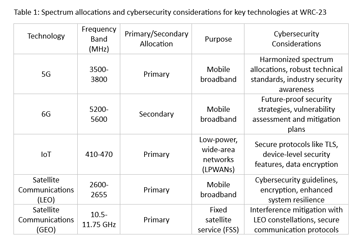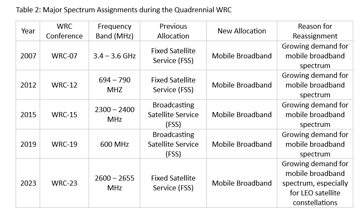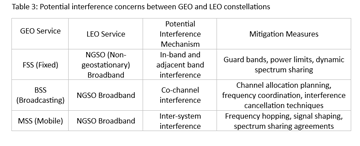Key Takeaways from WRC 2023
by Ehtisham Siddique
Dubai, UAE, December 31, 2023--The World Radiocommunication Conference 2023 (WRC-23) held in Dubai from November 20 to December 15, 2023 addressed the increasing demand for spectrum and the evolving technological landscape in the digital era, with a particular focus on cybersecurity. The article explores the impact of WRC-23 on 5G and 6G, the Internet of Things (IoT), satellite communications, and the crucial role of cybersecurity in shaping the future of radiocommunications. The conference's decisions on spectrum allocation are set to influence the characteristics, potential benefits, and challenges of future networks, ensuring secure operation. The article concludes that WRC-23 has laid a comprehensive framework for a secure, resilient, and innovative radiocommunications infrastructure, enabling new technologies, enhancing cybersecurity, and supporting growth across industries and societies.
ITU WRC-23: Shaping a Secure Future for Radiocommunications – Balancing New Technologies with Legacy Services
WRC-23, marked a pivotal juncture in the evolution of radiocommunications. With the world embracing digital transformation, WRC-23 focused on allocating spectrum for new technologies, developing harmonized technical standards, and ensuring cybersecurity, all while considering the needs of existing services. This article analyzes key outcomes and implications, focusing on 5G, 6G, IoT, and satellite communications, with particular attention to potential interference between GEO and LEO constellations.
Key Outcomes and Cybersecurity Considerations
•5G/6G: Spectrum allocations were finalized for 5G and 6G, paving the way for faster speeds and wider connectivity. However, cybersecurity needs paramount attention, with harmonized spectrum allocations, robust technical standards, and industry awareness playing crucial roles.
•IoT: Recognizing the vast potential of IoT, WRC-23 allocated additional spectrum for LPWANs. Secure protocols like TLS and device-level security features are essential to protecting IoT data and mitigating risks.
•Satellite Communications: New allocations were made for both LEO and GEO constellations, enabling broader reach and diverse applications. Cybersecurity guidelines, encryption strategies, and enhanced system resilience are critical for securing these systems.
Balancing Innovation with Legacy Concerns
WRC-23's emphasis on new technologies like 5G and LEO constellations must be balanced with the needs of existing satellite services, particularly GEO constellations. Concerns emerged regarding potential interference between GEO and LEO, with GEO operators expressing anxieties about spectrum sharing. Addressing these concerns necessitates:
particularly GEO constellations. Concerns emerged regarding potential interference between GEO and LEO, with GEO operators expressing anxieties about spectrum sharing. Addressing these concerns necessitates:
•Technical mitigation measures: WRC-23 adopted technical measures to minimize interference, such as guard bands and power limits. Further studies and collaborations between stakeholders are crucial to refine these approaches.
•Spectrum sharing frameworks: Developing flexible and efficient spectrum sharing frameworks can enable the coexistence of GEO and LEO systems, benefiting both parties while ensuring overall spectrum utilization.
•Collaborative dialogue: Continuous dialogue and information sharing between GEO and LEO operators, regulators, and other stakeholders are essential for achieving mutually beneficial solutions and ensuring a smooth transition towards a shared spectrum landscape.
Real-World Impact of WRC-23 Decisions
 •5G Deployment in Remote Areas: The additional allocation of mid-band spectrum at WRC-23 facilitates the expansion of 5G networks in remote and rural areas, improving connectivity and enabling new digital services.
•5G Deployment in Remote Areas: The additional allocation of mid-band spectrum at WRC-23 facilitates the expansion of 5G networks in remote and rural areas, improving connectivity and enabling new digital services.
•IoT in Smart Cities: Similarly, the exponential growth of IoT in smart city initiatives, highlights successfully integrated IoT solutions for urban management, such as traffic control, waste management, and energy efficiency.
•Satellite Communications in Disaster Management: The use of LEO and GEO satellite services in disaster management, focusing on real-time communication and data transmission during emergencies and disaster relief operations.
Beyond WRC-23: Addressing Challenges and Embracing Opportunities
WRC-23 laid the groundwork for a secure and resilient future of radiocommunications, but challenges remain. Cybersecurity threats require ongoing vigilance and adaptation, demanding international cooperation and industry-wide commitment. Further research and development efforts are needed to address technical aspects of spectrum sharing and interference mitigation. Embracing innovation while responsibly integrating new technologies with existing services will be crucial for continued progress in the dynamic world of radiocommunications.
Conclusion: Looking Ahead
WRC-23 delivered significant advancements in shaping the future of radiocommunications. Balancing the needs of new technologies with existing services, including satellite constellations, while ensuring cybersecurity, will be paramount in the years to come. Through collaboration, innovation, and responsible spectrum management, radiocommunications can continue to fuel communication networks, unlock new possibilities, and bridge the digital divide for a more connected future.
-----------------------------
Ehtisham Siddique, a seasoned SATCOM professional and author, has 13 years of experience in the telecom industry, with a focus on international projects. His expertise includes RF Architecture, RF Frequency Planning, Microwave, Teleport RF Operations, Network design, and Project management. Siddique's education in Electronic Engineering and certifications have given him a unique skill set in satellite communication, wireless technologies, and network design. He is currently pursuing a Master's research project on the progression of satellite and IoT technology. He can be reached at : e.ehtisham@gmail.com





